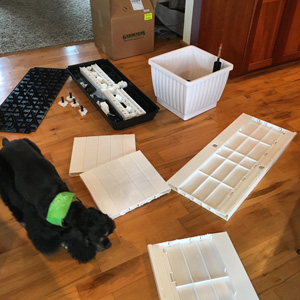
Assembly is a two-person job and reading the directions a must, as backing out of an error is really difficult.
This summer I’m testing self-watering planters. In cards and gardening you should always play to your strong suit. My strong suit does not include watering. If the plants are in the ground, then Mother Nature assists with making sure my gardens look great. In a pot and I’ll forget, neglect and return to find a sad, dry, frizzled remnant of a plant.
Thank heavens there are lots of options for self-watering pots and planters. They come in almost every size and color. Many are for specific uses such as indoors or window boxes. Depending on how much you want to spend there are some that include drip irrigation and are connected to a water source, while more economical options involve wicking systems and large water reservoirs.
Before purchasing I reviewed lots of DIY sites while I considered building self-watering planters or taking existing planters and creating self-watering systems. Some people are really inventive using kitchen sponges or baby diapers. One DIY’er was creating water reservoirs by sinking one planter into another and drilling holes through the upper pot. It all seemed like a lot of effort and possibly less attractive than the end result I was hoping for.

The bobbers let me know if there is enough, room for more or way too much water in each planter.06
In the end I purchased three tub sized rolling planters and really big trough sized rolling planter from Gardner’s Supply Company. My new trough holds 130 quarts of soil and whopping 4 gallons of water. It’s made of plastic so it’s easy to clean and care for. Best of all there is a “bobber” in the corner of each pot to let me know when the water is getting low and an overflow spigot if it gets too full of water.
I researched self-watering planter soil and discovered that there were two key goals – hold lots of water for long periods and reduce weight. In that my planters were plastic, the second goal was really important to me. I decided to create my own mix of planter soil using a combination of something I found on Pinterest from Martha Stewart and a Master Gardener site. My recipe was:
- 2 parts topsoil
- 1 part mushroom compost (for nutrients)
- 1 part perlite (for drainage)
- 2 parts peat moss (for water retention)
My pots are filled and I’ve tested the water notification system. Quite a few of my new white cutting garden flower seeds are already in place. Cross your fingers!

